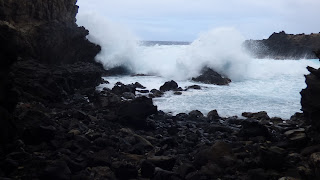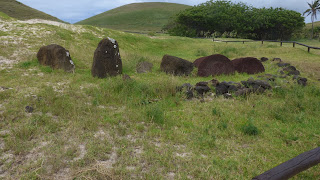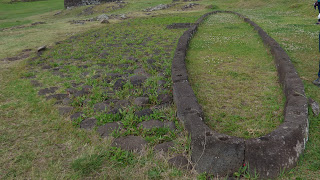When Easter Island was settled, a man and his sister owned the boats that were used. The sister ended up with half the island, and the man with the other half. There is a Moai for the sister, made of scoria - unlike every other Moai I saw. Only the body has been restored. A number of the other Moai that have been restored had to have concrete used to join the head to the body, but I guess that scoria would be difficult to join. The hat is still there too.
One of the hats had been made into a big water vessel, with petraglyphs around the outside.
Then we visited a site where nothing has been restored, and the Moai are still lying on the ground.
There were originally two separate Moai installations - each of several Moai. You can see the back of both platforms below. The first is older. It is thought that there was some communication between Easter Island and Peru before the second platform was built. The stones have all been trimmed a lot more than those of the first platform, and they show similar stonework to the Inca ruins.
We stopped at the high point of the island. From here you could see the town and the two volcanos at the tip of the island.
We then visited the birdman site. Originally, Easter Island had two peoples - the ruling class and the workers. The king of the island was hereditary from one clan, and the Moai were all ancestors of the ruling clans (I think there were about 12). The Moai were protecting the Island and their descendants, facing inland from the coast.
Then there was a revolution, at about the same time as explorers came to the islands. The first explorer noted that all the Moai were standing, but later ones reported that Moai were being toppled. The new "birdman" cult enabled any of the clans to have a person in charge for a year. Each clan would have a candidate, and when the migratory birds came to nest on these islands
the candidates would run down the side of the volcano, over the lip, down the cliffs to the sea. They would swim to the largest island and obtain an egg. The first one back with the egg was the ruler for the next year. There was a lot of hokey pokey, and deaths of some of the contestants was normal during the race. the stones in front of the crater have birdman petroglyphs on them.
There were a lot of houses built here during the birdman period. Unlike earlier houses, the stones were all shaped into thin blocks which were built into the houses.
One was cut away to show how it was constructed inside. Basically it had the same boat shaped interior of the earliest houses.
There was a quarry next to the crater where the stone was obtained.
There were traces of platforms where Moai had stood, and it is thought that even after the birdman cult started, people were still raising Moai here. However, the platform is one of the smallest on the island, so it wouldn't have taken as many people to erect the Moai.
And then we went to a sea cave that has birdman drawings on its roof. Originally, there were fifteen caves along this part of the coastline with drawings in them, but the sea has made all but one of them inaccessible.
Wednesday, 21 November 2018
Quarry
We visited a site where they recreated the original boat shaped grass houses.
There were many more houses dotting the area, giving you a perspective of the size of the village that had been here.
There were a number of Moai that had been toppled - you can see a couple of the hats in the foreground.
One of the hats had been carved with a petroglyph.
The coast around the island is almost uniformly rocky with lots of surf and spray.
We then went to the Moai quarry.
There are a number of Moai that were never separated from the stone beneath them - some of them are the largest ever formed.
Even here, later Islanders carved many petroglyphs
After the Moai were separated from the quarry, they were stood up for further work prior to being moved to where they would end up standing. These are all clearly unfinished Moai because their eyes were not shaped until they were at their final destination. But they also still have pieces at the back that needed to be chipped off before they were moved. And the ears needed to be carved as well.
There were a number of Moai that had never reached their goal, lying on the ground on the way to their destined positions.
Then we went to the fifteen Moai on the platform at the coast near the quarry. Moai were generally added to platforms as important people died. The leftmost Moai is the first, and others are gradually added to the right, so this would not have been fifteen friends - they might represent fifteen generations.
Here, there were several places where petroglyths had been carved.
This was a place where births took place
And these were lodestones.
On a second platform the Moai had been toppled. The stones at the back of the platform had been carefully laid - you can see the quarry in the background.
But you could see the Moai scattered around.
We went to a beach near the quarry. There was a beach at the town, but this was much bigger, and the only real beach I saw on Easter Island.
The Moai here were the last ones to be toppled, and possibly because of the sand, they had fared better than a number of others around the island - their hats were even in a good enough condition to be put back on when they were restored.
One of the graves at the back was still visible.
And petroglyphs had been carved on the back of each Moai.
There were many more houses dotting the area, giving you a perspective of the size of the village that had been here.
There were a number of Moai that had been toppled - you can see a couple of the hats in the foreground.
One of the hats had been carved with a petroglyph.
The coast around the island is almost uniformly rocky with lots of surf and spray.
We then went to the Moai quarry.
There are a number of Moai that were never separated from the stone beneath them - some of them are the largest ever formed.
Even here, later Islanders carved many petroglyphs
After the Moai were separated from the quarry, they were stood up for further work prior to being moved to where they would end up standing. These are all clearly unfinished Moai because their eyes were not shaped until they were at their final destination. But they also still have pieces at the back that needed to be chipped off before they were moved. And the ears needed to be carved as well.
There were a number of Moai that had never reached their goal, lying on the ground on the way to their destined positions.
Then we went to the fifteen Moai on the platform at the coast near the quarry. Moai were generally added to platforms as important people died. The leftmost Moai is the first, and others are gradually added to the right, so this would not have been fifteen friends - they might represent fifteen generations.
Here, there were several places where petroglyths had been carved.
This was a place where births took place
And these were lodestones.
On a second platform the Moai had been toppled. The stones at the back of the platform had been carefully laid - you can see the quarry in the background.
But you could see the Moai scattered around.
The Moai here were the last ones to be toppled, and possibly because of the sand, they had fared better than a number of others around the island - their hats were even in a good enough condition to be put back on when they were restored.
One of the graves at the back was still visible.
And petroglyphs had been carved on the back of each Moai.
Moai
The Easter Island Museum is well worth visiting prior to seeing the rest of Easter Island, as it has an excellent description of the island and its cultural history. I was particularly interested in the navigation aids and the Easter Island calligraphy.
We then went to the harbour. The guide put some breadcrumbs in the water, and in no time, the water was teeming wint small fish fighting over the crumbs
As it was Sunday, everyone was at the church for mass. You've all heard recordings of Pacific Islanders at church, and this was just the same. The church was full, and we we entered, and were made part of the service. It was great!
We expolred the town some more. All weekend the soccer field was being used for games.
We started to visit the statues. The first one was by itself away from the coast. Every single Maoi on Easter Island was toppled, so all the standing Moai have been rebuilt. This one shows the way they were created. The Maoi is on a stone plinth, with a second platform spreading out a bit lower, with rocks evenly spaced throughout the platform. Next there is a third platform that is just grass, but again, it can't be stood upon by normal people.
Behind the Moai, there is a grave where the original person's body is buried. The spirit from the body has inhabited the Moai.
At this site there were also two other artifacts. The first is a basin made from stone that has been carved out so water can be collected. As the stone is scoria, this was probably originally the hat for the Moai - after the Moai were toppled many of the hats were repurposed. The island has no running water so it was very important to the inhabitants to collect water where ever they could. The second is a cooking pit where they buried food and made fire with coals on top of the pit.
Then we visited the quarry for the hats for the Moai. Originally they all had hats, but most now don't. The hats were all of scoria, and so came from a different quarry to the Moai themselves, which were mainly of a different rock (although some were of scoria too). The hats were all lying around where they had ended up. as they were cylinders and of scoria, they were much easier to move than the Maoi themselves. As the Moai making progressed, different hairstyles for the hats were used.
Some of them had petroglyphs on them that were added when the birdman cult was being followed (after the Moai).
The first people to come to Easter Island were a group of seven explorers who were trying to find more islands for the Polynesians to inhabit. One of the sailors had dreamed of the island, and they all came here. One died while they were exploring, but the rest went back and brought the original settlers back with them. As a result these seven explorers were very important, and they were all celebrated with Moai.
After this, we went back to a site near the museum, where there were three separate platforms of Moai, and a number of buildings. The boat shape is the foundation for a grass and pole building where a family lived. The entrance is in the middle on the stone platform side.
Later, they started to build circular buildings to live in, and they also made circular chicken coupes. You can see the difference because the chicken coupes are much lower. As they were made of stone, the birds sheltered in them overnight but never laid their eggs in the coupes.
There is one complete Moai in this location (the only complete Moai I saw) - it has a hat and its eyes are in place - coral for the whites and obsidian for the iris.
This was a very important site, and there was a ceremonial boat ramp between the group of Moai and the first individual Moai.
And lastly, this is where I'm staying
We then went to the harbour. The guide put some breadcrumbs in the water, and in no time, the water was teeming wint small fish fighting over the crumbs
As it was Sunday, everyone was at the church for mass. You've all heard recordings of Pacific Islanders at church, and this was just the same. The church was full, and we we entered, and were made part of the service. It was great!
We expolred the town some more. All weekend the soccer field was being used for games.
We started to visit the statues. The first one was by itself away from the coast. Every single Maoi on Easter Island was toppled, so all the standing Moai have been rebuilt. This one shows the way they were created. The Maoi is on a stone plinth, with a second platform spreading out a bit lower, with rocks evenly spaced throughout the platform. Next there is a third platform that is just grass, but again, it can't be stood upon by normal people.
Behind the Moai, there is a grave where the original person's body is buried. The spirit from the body has inhabited the Moai.
At this site there were also two other artifacts. The first is a basin made from stone that has been carved out so water can be collected. As the stone is scoria, this was probably originally the hat for the Moai - after the Moai were toppled many of the hats were repurposed. The island has no running water so it was very important to the inhabitants to collect water where ever they could. The second is a cooking pit where they buried food and made fire with coals on top of the pit.
Then we visited the quarry for the hats for the Moai. Originally they all had hats, but most now don't. The hats were all of scoria, and so came from a different quarry to the Moai themselves, which were mainly of a different rock (although some were of scoria too). The hats were all lying around where they had ended up. as they were cylinders and of scoria, they were much easier to move than the Maoi themselves. As the Moai making progressed, different hairstyles for the hats were used.
Some of them had petroglyphs on them that were added when the birdman cult was being followed (after the Moai).
The first people to come to Easter Island were a group of seven explorers who were trying to find more islands for the Polynesians to inhabit. One of the sailors had dreamed of the island, and they all came here. One died while they were exploring, but the rest went back and brought the original settlers back with them. As a result these seven explorers were very important, and they were all celebrated with Moai.
After this, we went back to a site near the museum, where there were three separate platforms of Moai, and a number of buildings. The boat shape is the foundation for a grass and pole building where a family lived. The entrance is in the middle on the stone platform side.
Later, they started to build circular buildings to live in, and they also made circular chicken coupes. You can see the difference because the chicken coupes are much lower. As they were made of stone, the birds sheltered in them overnight but never laid their eggs in the coupes.
There is one complete Moai in this location (the only complete Moai I saw) - it has a hat and its eyes are in place - coral for the whites and obsidian for the iris.
This was a very important site, and there was a ceremonial boat ramp between the group of Moai and the first individual Moai.
And lastly, this is where I'm staying
Subscribe to:
Comments (Atom)























































